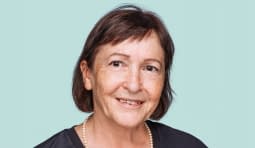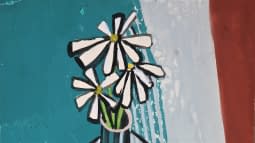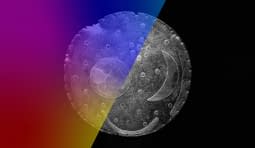Artist Interview with Mu
Yvonne: Hello Mu and thank you for giving us insights into your artistic life. So, my first question would be, if you can tell us about your experience and journey with art. Has it always been part of your life or how did you get into art?
Mu: I've always been more of a composer, my creative inclination leaning more towards music than digital art. My initial artistic exposure came at a young age via album covers such as “Sgt. Pepper”, “Dark Side of the Moon”, “Goo”, “Incesticide”, “Velvet Underground”, “You”, etc; each leaving somewhat of a mark on me. While pop art icons like Roy Lichtenstein and Andy Warhol and their vibrant movement did catch my attention in my late teens, the thought of pursuing art beyond music didn't really cross my mind until fairly recently.
Yvonne: In your works you often use geometric shapes and primary colours. Where does this interest/need come from? Thoughts of the Bauhaus (1919-33) come to mind. Were you influenced by it?
Mu: I became interested in Bauhaus not too long after arriving in Berlin and was fascinated with how a lot of the works were so basic, so simplistic and yet able to express so much. I had already made up my mind to start creating digital art but was yet to find a style I liked. I liked the geometry and colours of Bauhaus and decided to apply a similar ‘haiku’ approach, limiting myself to basic shapes and colours in order to create from this point.
Yvonne: In many works it seems as if you are exploring the spaces in which we move. What is it that intrigues you about spaces?
Mu: I am interested in the ways that spaces can affect our emotions: as an introvert I feel most at ease in the familiar space of my apartment and I can feel overwhelmed in unfamiliar, crowded spaces. At the same time, I am very aware that I co-exist with many others in our apartment block and in the city of Berlin more widely, and in my art I like to explore our ‘collective aloneness’ (see ‘Neighbours’) and our relationships across space.
Yvonne: What does the digital space mean to you and your art?
Mu: Without the digital space I would not be able to create my art. It opens up a myriad of possibilities to let my imagination flow. I have always been a procrastinator: I do one thing, a thought pops into my head, and 20 minutes later I will find myself doing something completely different to what I had planned. In the process of creating digital art this can be a good thing because a series of small, original ideas inspired by the vastness of the internet can become a whole.
Yvonne: And how is it when you create your works on the computer and look into this square room full of possibilities: Does that inspire you, or do you sometimes feel lost?
Mu: Working with a limited pallet of shapes and colours give me a sense of ‘freedom within restriction’ and actually boosts my creativity. This can make the ‘look into the square room full of possibilities’ less scary. I have three main approaches to creating a work of art: (1) applying simple shapes and colours to a blank ‘canvas’ with no goal in mind, simply adding lines and shadow to see if anything interesting happens (I am an observer/the witness in this approach). (2) I make photo collages and create on top of them. This approach helps me to create more complex visuals. (3) I have a preconceived idea, which I can picture in my mind, and then try and capture it as closely as possible.
Yvonne: Sometimes one finds very reduced human figures in your works. What role do they play in your works and why do you reduce them to these anonymous figures?
Mu: I like playing with the human figure as a shape like any other. Adding too many details (giving them features, names, a smile) would take attention away from the relationship between the shapes themselves (the human e and the geometric shapes) and the emotions they can evoke in combination. To me this is more interesting than trying to express emotions through the human face.
Yvonne: The always same choice of format of your works is striking. What does this regularity mean to you? And is it determined by your working technique?
Mu: Yes, the regularity of the format is very important to me. It is another aspect of my ‘Haiku’- approach: the self-imposed creativity-inducing restriction I mention above. My starting method is the same for every work I create: I start with an ‘off-yellow’ background and everything else is applied over this. I like that it gives my work its unique look – a continuous theme that runs through my body of work like it is all existing within the same space.
Yvonne: Often your objects and figures float in a bright (non-) room. Does this space represent something?
Mu: This question relates well to my previous answer about the grainy ‘off-yellow’ background and how it becomes the continuous space of all my works. I think that the background creates this sense of a (non-) room you mention. It is a negative space in the way that all objects exist within it, but it has its own personality in remaining constant and holding everything together.
Yvonne: My last questions would be about your blog article you wrote on the so called «state of flow». Does this state sometimes also scare you, when you completely loose yourself to art? Or would you rather describe it as freedom? And when you’re in the zone, are you then sometimes surprised by what has been created?
Mu: Great question! I am often very surprised by what comes out of flow state. I become the first recipient of my art, and I often find new meanings in a piece long after creating it. It is, however, not a scary state for me, I enjoy losing myself in the process of creation (also, my 11-moth-old son makes sure I come out of it regularly) and I love the sense of freedom it brings.
Yvonne: Thanks for taking your time and sharing with us!
You can find Mu's art24 profile here. Have fun discovering and buying his exciting artworks!
Glossary:
Haiku: Haiku is a traditional Japanese poetry form and is considered the shortest poetry style in the world.








